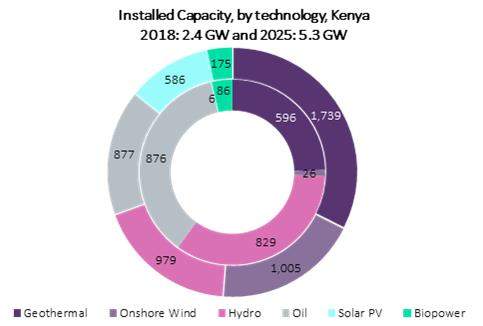Kenya stands tall among African countries as far as geothermal energy is concerned, with a capacity of 600 megawatts (MW) as of 2017. To put this in perspective, geothermal technology is still in its nascent stage, with the highest capacity being installed by the US at 3.8 gigawatts (GW). It is followed by Indonesia with 1.96GW, the Philippines with 1.9GW, and Turkey with 1GW of installed capacity.
In 2017, Kenya’s demand for electricity exceeded 1.5GW. The country has a total installed capacity of 2.4GW. Geothermal contributes one-quarter of its installed capacity but has more than a 45% share in the country’s overall electricity generation. Capacity is expected to triple during the period 2018–2025 to reach 1.7GW. Geothermal is expected to provide more than one-third of the total installed capacity and around 55% of the country’s electricity generation by 2025.
Figure 1: installed capacity, by technology, Kenya, 2018: 2.4 GW and 2025: 5.3 GW

| Source: GlobalData |
Figure 2: geothermal installed capacity MW, 2018-2025, Kenya

| Source: GlobalData |
The Kenyan government has set a new energy policy that directs Kenya Electricity Generating Company (KenGen), along with the country’s independent power producers, to eliminate fossil fuel-powered generation. Also, as per the Kenya Vision 2030 energy plan, most of the country’s electricity has to come from renewable sources, at the utility, commercial, and industrial scales, and as off-grid solutions, in 2030 and beyond.
Geothermal could prove to be a promising source of renewable energy for Kenya. The country has a vast geothermal potential along the world-famous East African Rift valley that transects the country from north to south. According to KenGen, which generates most of Kenya’s electricity, geothermal technology has a potential of more than 10GW in the country. The technology also has the lowest unit cost and is suitable for base-load application.

US Tariffs are shifting - will you react or anticipate?
Don’t let policy changes catch you off guard. Stay proactive with real-time data and expert analysis.
By GlobalDataKenGen is in the process of building a new 140MW plant, financed by a $400m loan from the Japan International Cooperation Agency (JICA), Japan’s development agency, which is expected to start running in 2018. Private developer Quantum Power East Africa secured loans of up to $50m from Climate Investment Funds, through the Clean Technology Fund, for its 35MW geothermal development at Menengai, Kenya. The project is one of three modular geothermal plants in the Menengai field, which have a combined capacity of 105MW. JICA signed a loan agreement with the government of Kenya in Nairobi to provide a Japanese ODA loan of up to JPY10.077 billion ($94m) for the Olkaria I units 1, 2, and 3 Geothermal Power Plant Rehabilitation Project.
Kenya and other African nations face many challenges in harnessing geothermal potential. Lack of funding and technical expertise, poor governance, and corruption are key impediments to development. The Kenyan government is putting efforts into creating an enabling environment to enhance investment flows from private investors to the energy sector. The government is encouraging implementation of competitive tender processes in an attempt to lower the unit costs of geothermal power generation while lowering the costs of doing business and thus improving Kenya’s competitiveness in the region. It is also currently working on expanding national grid with about 1,500 miles of new electrical lines under construction and 3,600 miles in the works by Kenya Electricity Transmission Company.
According to estimates, only about 40% of the population of Kenya has access to reliable electricity. If efforts are made in the right direction, geothermal energy can be used to provide affordable electricity to the majority of the population.





